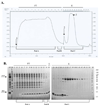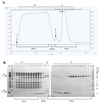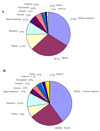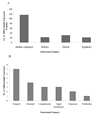Quantitative analysis of age specific variation in the abundance of human female parotid salivary proteins
- PMID: 19764810
- PMCID: PMC2834885
- DOI: 10.1021/pr900478h
Quantitative analysis of age specific variation in the abundance of human female parotid salivary proteins
Abstract
Human saliva is a protein-rich, easily accessible source of potential local and systemic biomarkers to monitor changes that occur under pathological conditions; however, little is known about the changes in abundance associated with normal aging. In this study, we performed a comprehensive proteomic profiling of pooled saliva collected from the parotid glands of healthy female subjects, divided into two age groups 1 and 2 (20-30 and 55-65 years old, respectively). Hydrophobic charge interaction chromatography was used to separate high- from low-abundance proteins prior to characterization of the parotid saliva using multidimensional protein identification technology (MudPIT). Collectively, 532 proteins were identified in the two age groups. Of these proteins, 266 were identified exclusively in one age group, while 266 proteins were common to both groups. The majority of the proteins identified in the two age groups belonged to the defense and immune response category. Of note, several defense related proteins (e.g., lysozyme, lactoferrin and histatin-1) were significantly more abundant in group 2 as determined by G-test. Selected representative mass spectrometric findings were validated by Western blot analysis. Our study reports the first quantitative analysis of differentially regulated proteins in ductal saliva collected from young and older female subjects. This study supports the use of high-throughput proteomics as a robust discovery tool. Such results provide a foundation for future studies to identify specific salivary proteins which may be linked to age-related diseases specific to women.
Figures






Similar articles
-
Quantitative proteomics of parotid saliva in primary Sjögren's syndrome.Proteomics. 2012 Oct;12(19-20):3113-20. doi: 10.1002/pmic.201200208. Epub 2012 Sep 10. Proteomics. 2012. PMID: 22888089 Free PMC article.
-
Toward defining the human parotid gland salivary proteome and peptidome: identification and characterization using 2D SDS-PAGE, ultrafiltration, HPLC, and mass spectrometry.Biochemistry. 2005 Mar 1;44(8):2885-99. doi: 10.1021/bi048176r. Biochemistry. 2005. PMID: 15723531
-
Trafficking and postsecretory events responsible for the formation of secreted human salivary peptides: a proteomics approach.Mol Cell Proteomics. 2008 May;7(5):911-26. doi: 10.1074/mcp.M700501-MCP200. Epub 2008 Jan 9. Mol Cell Proteomics. 2008. PMID: 18187409
-
Effect of donor age on the concentrations of histatins in human parotid and submandibular/sublingual saliva.Arch Oral Biol. 2000 Sep;45(9):731-40. doi: 10.1016/s0003-9969(00)00047-9. Arch Oral Biol. 2000. PMID: 10869486
-
The proteomes of human parotid and submandibular/sublingual gland salivas collected as the ductal secretions.J Proteome Res. 2008 May;7(5):1994-2006. doi: 10.1021/pr700764j. Epub 2008 Mar 25. J Proteome Res. 2008. PMID: 18361515 Free PMC article.
Cited by
-
Variation of Human Salivary O-Glycome.PLoS One. 2016 Sep 9;11(9):e0162824. doi: 10.1371/journal.pone.0162824. eCollection 2016. PLoS One. 2016. PMID: 27610614 Free PMC article.
-
Review Insights on Salivary Proteomics Biomarkers in Oral Cancer Detection and Diagnosis.Molecules. 2023 Jul 7;28(13):5283. doi: 10.3390/molecules28135283. Molecules. 2023. PMID: 37446943 Free PMC article. Review.
-
Human common salivary protein 1 (CSP-1) promotes binding of Streptococcus mutans to experimental salivary pellicle and glucans formed on hydroxyapatite surface.J Proteome Res. 2010 Dec 3;9(12):6605-14. doi: 10.1021/pr100786y. Epub 2010 Oct 22. J Proteome Res. 2010. PMID: 20858015 Free PMC article.
-
Lactoferrin and oral diseases: current status and perspective in periodontitis.Ann Stomatol (Roma). 2011 Mar;2(3-4):10-8. Epub 2012 Jan 27. Ann Stomatol (Roma). 2011. PMID: 22545184 Free PMC article.
-
Starch treatment improves the salivary proteome for subject identification purposes.Forensic Sci Med Pathol. 2024 Mar;20(1):117-128. doi: 10.1007/s12024-023-00629-y. Epub 2023 Apr 21. Forensic Sci Med Pathol. 2024. PMID: 37084127 Free PMC article.
References
-
- Berkovitz B, Holland G, Moxham B. Oral anatomy, histology and embryology. 3rd ed. New York: Mosby; 2002.
-
- Slavkin HC. Toward molecularly based diagnostics for the oral cavity. J. Am. Dent. Assoc. 1998;129(8):1138–1143. - PubMed
-
- Dagogo-Jack S, Rodger SC, Laylor PK. Increased salivary concentration of human epidermal growth factor in patients undergoing CAPD. Peritoneal Dialysis International. 1991;11:270–273. - PubMed
Publication types
MeSH terms
Substances
Grants and funding
LinkOut - more resources
Full Text Sources
Medical
Molecular Biology Databases

